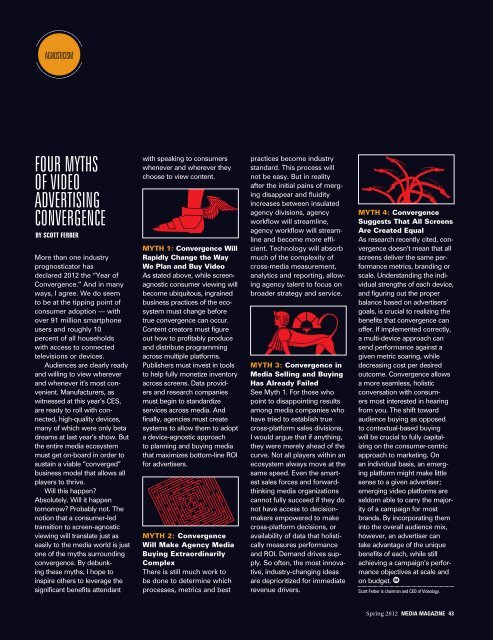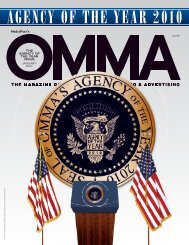THIRD ANNUAL SCREENS ISSUE - MediaPost
THIRD ANNUAL SCREENS ISSUE - MediaPost
THIRD ANNUAL SCREENS ISSUE - MediaPost
Create successful ePaper yourself
Turn your PDF publications into a flip-book with our unique Google optimized e-Paper software.
AGNOSTICISM<br />
FOUR MYTHS<br />
OF VIDEO<br />
ADVERTISING<br />
CONVERGENCE<br />
BY SCOTT FERBER<br />
More than one industry<br />
prognosticator has<br />
declared 2012 the “Year of<br />
Convergence.” And in many<br />
ways, I agree. We do seem<br />
to be at the tipping point of<br />
consumer adoption — with<br />
over 91 million smartphone<br />
users and roughly 10<br />
percent of all households<br />
with access to connected<br />
televisions or devices.<br />
Audiences are clearly ready<br />
and willing to view wherever<br />
and whenever it’s most convenient.<br />
Manufacturers, as<br />
witnessed at this year’s CES,<br />
are ready to roll with connected,<br />
high-quality devices,<br />
many of which were only beta<br />
dreams at last year’s show. But<br />
the entire media ecosystem<br />
must get on-board in order to<br />
sustain a viable “converged”<br />
business model that allows all<br />
players to thrive.<br />
Will this happen?<br />
Absolutely. Will it happen<br />
tomorrow? Probably not. The<br />
notion that a consumer-led<br />
transition to screen-agnostic<br />
viewing will translate just as<br />
easily to the media world is just<br />
one of the myths surrounding<br />
convergence. By debunking<br />
these myths, I hope to<br />
inspire others to leverage the<br />
significant benefits attendant<br />
with speaking to consumers<br />
whenever and wherever they<br />
choose to view content.<br />
MYTH 1: Convergence Will<br />
Rapidly Change the Way<br />
We Plan and Buy Video<br />
As stated above, while screenagnostic<br />
consumer viewing will<br />
become ubiquitous, ingrained<br />
business practices of the ecosystem<br />
must change before<br />
true convergence can occur.<br />
Content creators must figure<br />
out how to profitably produce<br />
and distribute programming<br />
across multiple platforms.<br />
Publishers must invest in tools<br />
to help fully monetize inventory<br />
across screens. Data providers<br />
and research companies<br />
must begin to standardize<br />
services across media. And<br />
finally, agencies must create<br />
systems to allow them to adopt<br />
a device-agnostic approach<br />
to planning and buying media<br />
that maximizes bottom-line ROI<br />
for advertisers.<br />
MYTH 2: Convergence<br />
Will Make Agency Media<br />
Buying Extraordinarily<br />
Complex<br />
There is still much work to<br />
be done to determine which<br />
processes, metrics and best<br />
practices become industry<br />
standard. This process will<br />
not be easy. But in reality<br />
after the initial pains of merging<br />
disappear and fluidity<br />
increases between insulated<br />
agency divisions, agency<br />
workflow will streamline,<br />
agency workflow will streamline<br />
and become more efficient.<br />
Technology will absorb<br />
much of the complexity of<br />
cross-media measurement,<br />
analytics and reporting, allowing<br />
agency talent to focus on<br />
broader strategy and service.<br />
MYTH 3: Convergence in<br />
Media Selling and Buying<br />
Has Already Failed<br />
See Myth 1. For those who<br />
point to disappointing results<br />
among media companies who<br />
have tried to establish true<br />
cross-platform sales divisions,<br />
I would argue that if anything,<br />
they were merely ahead of the<br />
curve. Not all players within an<br />
ecosystem always move at the<br />
same speed. Even the smartest<br />
sales forces and forwardthinking<br />
media organizations<br />
cannot fully succeed if they do<br />
not have access to decisionmakers<br />
empowered to make<br />
cross-platform decisions, or<br />
availability of data that holistically<br />
measures performance<br />
and ROI. Demand drives supply.<br />
So often, the most innovative,<br />
industry-changing ideas<br />
are deprioritized for immediate<br />
revenue drivers.<br />
MYTH 4: Convergence<br />
Suggests That All Screens<br />
Are Created Equal<br />
As research recently cited, convergence<br />
doesn’t mean that all<br />
screens deliver the same performance<br />
metrics, branding or<br />
scale. Understanding the individual<br />
strengths of each device,<br />
and figuring out the proper<br />
balance based on advertisers’<br />
goals, is crucial to realizing the<br />
benefits that convergence can<br />
offer. If implemented correctly,<br />
a multi-device approach can<br />
send performance against a<br />
given metric soaring, while<br />
decreasing cost per desired<br />
outcome. Convergence allows<br />
a more seamless, holistic<br />
conversation with consumers<br />
most interested in hearing<br />
from you. The shift toward<br />
audience buying as opposed<br />
to contextual-based buying<br />
will be crucial to fully capitalizing<br />
on the consumer-centric<br />
approach to marketing. On<br />
an individual basis, an emerging<br />
platform might make little<br />
sense to a given advertiser;<br />
emerging video platforms are<br />
seldom able to carry the majority<br />
of a campaign for most<br />
brands. By incorporating them<br />
into the overall audience mix,<br />
however, an advertiser can<br />
take advantage of the unique<br />
benefits of each, while still<br />
achieving a campaign’s performance<br />
objectives at scale and<br />
on budget.<br />
Scott Ferber is chairman and CEO of Videology.<br />
Spring 2012 MEDIA MAGAZINE 43








